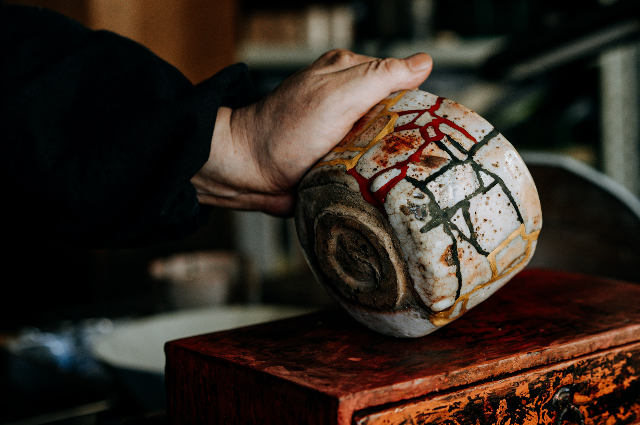
Photo by Motoki Tonn on Unsplash
What is considered art? Everyone has different opinions and expectations as to what art should look like. But in reality, everything and anything can be considered art. One might see art in the smile of a child while the other might see art in the death of a person. There’s art in leaves turning old during fall and there’s art in sea waves thrashing rocks on the shore. There’s art everywhere if you know how to look. Beauty and art are similar that way. Unpopular opinion is that art doesn’t have to be perfect or complete to be considered as art. From a single brush stroke to the unfinished Beethoven's 10th symphony, there’s beauty in transience everywhere. The ancient Japanese philosophy wabi-sabi embraces this beauty in imperfection. Wabi-sabi practice is believing that you don't have to be anything, your existence in itself is the most beautiful thing. Kintsugi is a classic art form that epitomizes wabi-sabi the most. Kintsugi which is now treated as an art form was originally used as a technique to repair ceramic ware. Kintsugi involves mending the cracks of broken pots by using urushi (Japanese lacquer) dusted with gold.
Urushi is made from tree sap. This material has been used for some 9,000 years by Japanese lacquer masters as glue, putty, or paint. The process starts by gluing broken pieces using lacquer. It’s also used to fill any gaps or holes caused by missing pieces. This part is tricky because it cannot be removed once it’s dried. When the broken pieces are huge, it’s hard to apply them carefully everywhere while being quick. After the lacquer dries and hardens, a final coat of gold is applied over lacquer seams. The common misconception is that gold is used to join the pieces whereas, in reality, it’s just used as a final coating over lacquer for aesthetic purposes.
The reason for this misconception being the meaning of kintsugi (Kin: golden, tsugi: joinery). The origin of this art form is said to be during the muromachi period. When the shogun of Japan at the time, Ashikaga Yoshimitsu accidentally broke his favourite tea bowl, he sent it to China to get it repaired. But the repair job, which was done with metal staples being the standard for repair at that time - detracted from the beauty of the bowl. Disappointed, the shogun enlisted Japanese craftsmen to come up with a more aesthetically pleasing solution, and kintsugi was born. We are defined by what we’ve been through. This is why the ancient art form, rather than trying to disguise the damage, made something artful and beautiful out of it by emphasizing those cracks. The scars from the past become a part of the history of the new beautiful version of it. The repair method was also born from the Japanese feeling of mottainai, which expresses regret when something is wasted, as well as mushin, the acceptance of the change.
There are 3 predominant styles of Kintsugi: crack, piece method, and joint-call. While, in each case, gold, silver, or platinum-dusted epoxy is used to fix the broken pottery, the techniques and finished results vary.
CRACK:
Objects mended using the crack approach are touched up with minimal lacquer. This is the most common Kintsugi technique, and it culminates in the shimmering veins that have come to define the art form.PIECE METHOD:
Works restored with the piece method feature replacement fragments made entirely of epoxy.JOINT-CALL:
Pieces fixed using the joint-call technique employ similarly-shaped pieces from other broken wares, combining two aesthetically different works into one uniquely unified product.Collectors of kintsugi are so enamored of the art that some were accused of deliberately smashing valuable pottery so it could be repaired with the gold seams of kintsugi. Internationally acclaimed kintsugi artist and urushi master Mio Heki says “Timing is very important in kintsugi handicraft. I’m very focused when I’m working. Sometimes I can really connect to the piece that I’m repairing. It‘s like I’m having a conversation with the object through which I get to know both the owner and the piece. It makes me truly happy that I can help create new life stories through my handicraft. It is not easy to be a full-time artist but I find the craftsmanship of kintsugi too interesting to let it go and it is also crucial to keep our traditional handicrafts alive. Today, a lot of people don’t even know what urushi is. Japanese people easily forget about our precious culture and the younger generations are not interested in preserving ancient crafts. Therefore I find it important to share my knowledge and thoughts. I arrange workshops both at my studio and at my house and every now and then I teach kintsugi classes in Europe. By helping to spread the word to the rest of the world, the information might travel back to Japan and catch people’s interest again” in an interview. Many artists like Charlotte Bailey, tomomi kamoshita and yee sookyung bring their own unique style and signature to the art.
Kintsugi is more than just an art form. It stands for hope and resilience. It is proof that you can be full again even though you were broken at some point. Many consider kintsugi a therapeutic art form. Especially in times like these, kintsugi gives us much-needed inspiration. The pandemic outbreak was chaotic and we’re all still adjusting to the new normal. But sooner or later, we will make this part of our history and learn from it.
